
 |
HOME |
An Apiarist's Bees
PART THREE |
||||
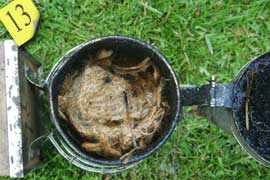 The Bee Smoker simply consists of a metal container with a hinged spout. Here hessian sacking has been used, but any material which burns gently without exuding toxic fumes will do including fir cones, sedge grass or even rotten wood. Once lit and the lid closed the smoke is puffed out of the spout by squeezing a small hand bellows on the side. |
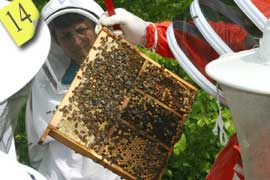 Don now extracts each Brood Frame and under the watchful eye of other members of the bee keeper's association examines the brood for signs of disease and for any infestations. Don is also looking for the queen, and to see whether there are any other queens in the hive. |
||||
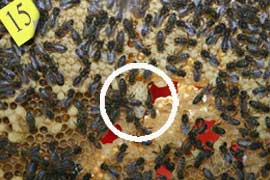 To the trained eye it's obvious that there is a queen cell on this frame, but for the likes of you and I, I've circled it. Inside is the pupa of a queen that is being nurtured by her worker bees. Other cells seen here contain the pupae of worker bees. GO TO PHOTO OF ADULT QUEEN |
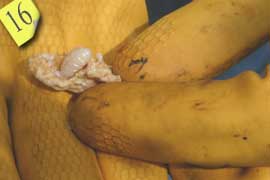 Don found two queens in the hive so this pupa was removed. Having two queens is disastrous for an apiarist as invariably one of the queens will take her leave, and a large number of worker bees with her. These bees will swarm until they find a new site for their brood. GO TO PHOTO OF SWARM |
||||
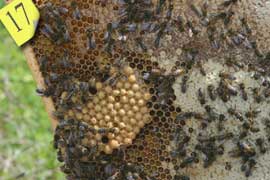 Here is a good example of where the bees have mixed in honey storage (the white cells at right) with the pupae (at left). You can see clearly the sealed pupae cells which are awaiting the metamorphoses of pupae to adult bees. These particular cells are larger than the others and contain male drone bees.This is also a good example of what the sealed honeycomb looks like. |
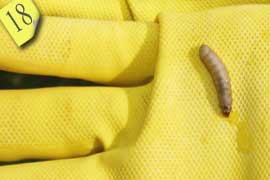 An apiarist's nightmare, the larva of a greater wax moth. A wax moth infestation undetected will within a couple of days completely ruin a frame, and if the infestation is left completely unchecked can ruin the whole hive. A strong colony will usually prevent any intrusion by wax moths. As the wax moths move through the hive they spin a silk covering for warmth and protection. |
||||
| NEXT | |||||
| Suggest a topic for another Wey River photo-essay |
|||||